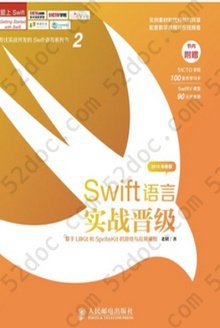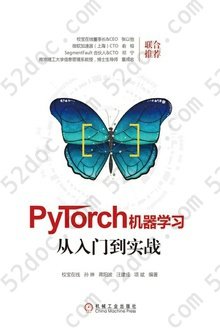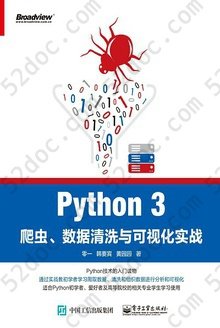注重体验与质量的电子书资源下载网站
分类于: 编程语言 互联网
简介

Programming Elixir: Functional |> Concurrent |> Pragmatic |> Fun 豆 8.1分
资源最后更新于 2020-10-28 12:17:28
作者:Dave Thomas
出版社:The Pragmatic Bookshelf
出版日期:2013-01
ISBN:9781937785581
文件格式: pdf
标签: elixir programming 函数式编程 erlang FP 编程 Elixir 并发
简介· · · · · ·
As a developer, you’ve probably heard that functional programming techniques help manage the complexities of today’s real-world, concurrent systems. You’re also investigating designs that help you maximize uptime and manage security.
This book is your guide to Elixir, a modern, functional, and concurrent programming language. Because Elixir runs on the Erlang VM, and uses the u...
目录
Contents and Extracts
This book is currently in beta, so the contents and extracts will change as the book is developed.
Preface/Introduction
Conventional Programming
Pattern Matching
Assignment: I do not think it means what you think it means
More Complex Matches
Ignoring a Value With _
Variables Bind Once (Per Match)
Another way of looking at the equals sign
Immutability
You Already Have (Some) Immutable Data
Immutable Data Is Known Data
Performance Implications of Immutability
Coding With Immutable Data
Elixir Basics excerpt
Value Types
System Types
Collection Types
Names, Source Files, Conventions, Operators, and So On
End of the Basics
Anonymous Functions
Functions and Pattern Matching
One Function, Multiple Bodies
Functions Can Return Functions
Passing Functions as Arguments
Functions Are The Core
Modules and Named Functions
The Body of the Function is a Block
Function Calls and Pattern Matching
Guard Clauses
Default Parameters
|> — The Amazing Pipe Operator
Modules
Module Attributes
Module Names: Elixir, Erlang, and Atoms
Lists and Recursion
Heads and Tails
Using Head and Tail to Process a List
Using Head and Tail to Build a List
Creation of a Map Function
Keeping Track of Values During Recursion
More Complex List Patterns
List Comprehensions
Using the Built-in Libraries
Strings and Binaries
String Literals
The Name “strings”
Single Quoted Strings—Lists of Character Codes
Binaries
Double Quoted Strings are Binaries
Binaries and Pattern Matching
Records
Defining Records: defrecord
Records and Pattern Matching
Advanced Records
Control Flow
if and unless
cond
case
Raising Exceptions
Designing With Exceptions
What we’ve seen
Organizing a Project
The Project: Fetch Issues from Github
Task: Use Mix to Create our New Project
Transformation: Parse the Command Line
Step: Write Some Basic Tests
Transformation: Fetch from Github
Task: Use External Libraries
Transformation: Convert Response
Transformation: Take First N Items
Transformation: Format the Table
Task: Make a command line executable (#sec.cmd-line}
Task: Test The Comments
Task: Create Project Documentation
What We’ve Just Seen
Concurrent Programming
Working With Multiple Processes
A Simple Process
Process Overhead
When Processes Die
Parallel Map—The Hello World of Erlang
A Fibonacci Server
What’s Next
Nodes—The Key To Distributing Services excerpt
Naming Nodes
Naming Your Processes
I/O, PIDs, and Nodes
What’s Next
OTP: Servers
Some OTP Definitions
An OTP Server
GenServer Callbacks
Naming A Process
Tidying Up The Interface
What We Learned
OTP: Supervisors
Supervisors And Workers
Supervisors Are The Heart of Reliability
OTP: Applications
Application: I do not think it means what you think it means
The Application Specification File
Turning Our Sequence Program into an OTP Application
Tell Mix About The Application
Create the application OTP entry point
Hot Code Swapping
OTP is Big. Unbelievably Big
Web Applications with Dynamo
More Advanced Elixir
Protocols
Use and Using
Macros
This book is currently in beta, so the contents and extracts will change as the book is developed.
Preface/Introduction
Conventional Programming
Pattern Matching
Assignment: I do not think it means what you think it means
More Complex Matches
Ignoring a Value With _
Variables Bind Once (Per Match)
Another way of looking at the equals sign
Immutability
You Already Have (Some) Immutable Data
Immutable Data Is Known Data
Performance Implications of Immutability
Coding With Immutable Data
Elixir Basics excerpt
Value Types
System Types
Collection Types
Names, Source Files, Conventions, Operators, and So On
End of the Basics
Anonymous Functions
Functions and Pattern Matching
One Function, Multiple Bodies
Functions Can Return Functions
Passing Functions as Arguments
Functions Are The Core
Modules and Named Functions
The Body of the Function is a Block
Function Calls and Pattern Matching
Guard Clauses
Default Parameters
|> — The Amazing Pipe Operator
Modules
Module Attributes
Module Names: Elixir, Erlang, and Atoms
Lists and Recursion
Heads and Tails
Using Head and Tail to Process a List
Using Head and Tail to Build a List
Creation of a Map Function
Keeping Track of Values During Recursion
More Complex List Patterns
List Comprehensions
Using the Built-in Libraries
Strings and Binaries
String Literals
The Name “strings”
Single Quoted Strings—Lists of Character Codes
Binaries
Double Quoted Strings are Binaries
Binaries and Pattern Matching
Records
Defining Records: defrecord
Records and Pattern Matching
Advanced Records
Control Flow
if and unless
cond
case
Raising Exceptions
Designing With Exceptions
What we’ve seen
Organizing a Project
The Project: Fetch Issues from Github
Task: Use Mix to Create our New Project
Transformation: Parse the Command Line
Step: Write Some Basic Tests
Transformation: Fetch from Github
Task: Use External Libraries
Transformation: Convert Response
Transformation: Take First N Items
Transformation: Format the Table
Task: Make a command line executable (#sec.cmd-line}
Task: Test The Comments
Task: Create Project Documentation
What We’ve Just Seen
Concurrent Programming
Working With Multiple Processes
A Simple Process
Process Overhead
When Processes Die
Parallel Map—The Hello World of Erlang
A Fibonacci Server
What’s Next
Nodes—The Key To Distributing Services excerpt
Naming Nodes
Naming Your Processes
I/O, PIDs, and Nodes
What’s Next
OTP: Servers
Some OTP Definitions
An OTP Server
GenServer Callbacks
Naming A Process
Tidying Up The Interface
What We Learned
OTP: Supervisors
Supervisors And Workers
Supervisors Are The Heart of Reliability
OTP: Applications
Application: I do not think it means what you think it means
The Application Specification File
Turning Our Sequence Program into an OTP Application
Tell Mix About The Application
Create the application OTP entry point
Hot Code Swapping
OTP is Big. Unbelievably Big
Web Applications with Dynamo
More Advanced Elixir
Protocols
Use and Using
Macros








